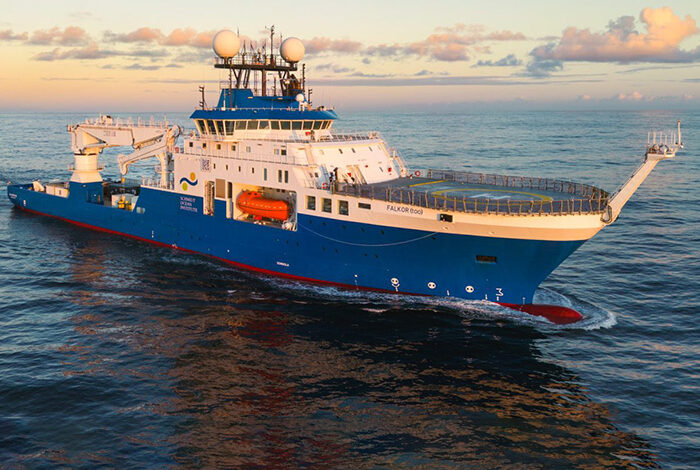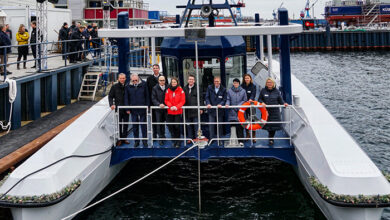
The Palo Alta, Calif., based Schmidt Ocean Institute has taken delivery of its newest research vessel, the Falkor (too). The 110 meter vessel was originally delivered in 2011 by Spain’s Freire shipyard as the GC Rieber IMR / Walk-to-Work vessel Polar Queen. The Schmidt Ocean Institute acquired the ship — minus the W2W gangway—in 2021 and awarded Freire the contract to refit it as a research vessel, a vessel type with which the shipyard has extensive experience.
An impressive seven-deck vessel, R/V Falkor (too) will offer scientists a modular platform to conduct almost any research at sea, with a 105-square-meter main laboratory in addition to seven other at-sea laboratories. The ship also features a 150-ton crane, two moonpools, equipment for high-resolution ocean depth mapping–which will contribute to a global effort to map the entire ocean floor by 2030–a microplastic water flow-through system, and 900-square meters of aft deck space for interdisciplinary ocean research and exploration.
In addition to the scientific and technical capabilities, the vessel is also outfitted with 98 berths, allowing for wider participation in expeditions by scientists, technologists, students, media, artists, and community leaders.

Funded by Schmidt Ocean Institute founders Eric and Wendy Schmidt, the R/V Falkor (too), will now embark on a series of expeditions and be available to scientists and technologists globally at no cost, in exchange for making their research and discoveries publicly available. The ship replaces Schmidt Ocean Institute’s previous research vessel, Falkor, which was in service for a decade and hosted more than 1,100 scientists, discovered over 50 new marine species and underwater formations and mapped over half a million square miles of the seafloor.
The last frontier
“The ocean is our planet’s last frontier, and the opportunities for exploration are immense,” said Wendy Schmidt, co-founder and president of Schmidt Ocean Institute. “Falkor (too) will make it possible to welcome more scientists aboard and to take them further and deeper into our unknown ocean, making possible a new and wondrous decade of discovery.”
As part of #ChapterToo, over next 10 years SOI plans to work on #FalkorToo around all 7 continents, focusing on 1 geographical region each year. As outlined in our strategic framework, we will explore, test tech & seek answers to questions about the Ocean https://t.co/EDC5WmuYtV pic.twitter.com/jNtaFB4aSR
— Schmidt Ocean (@SchmidtOcean) March 3, 2023
The ship’s inaugural science expedition will explore one of the world’s most extensive underwater mountain chains–the Mid-Atlantic Ridge. More than 20 scientists will study hydrothermal vents–hot springs on the ocean floor made by underwater volcanoes. The scientists will search for lost city vents–older hydrothermal towers made of limestone–that have a chemical makeup thought to be most similar to when life began on earth. The microbes living on these vents could provide insight into the conditions that facilitated life’s origin.
“The ocean has always needed a moonshot,” said Eric Schmidt (a former Google CEO and chairman). “Falkor (too) embodies that ambition, bringing together breakthrough technology and the global marine science community to explore the furthest reaches of our world. This is a very big moment for us, for the oceans and for the future of science.”
Schmidt Ocean Institute, founded by the Schmidts in 2009, began its exploration of the seas with R/V Lone Ranger, the precursor to R/V Falkor. The model of offering a state-of-the-art research vessel at no cost to scientists was revolutionary in marine science philanthropy when Falkor launched in 2013, and Schmidt Ocean spent the last decade building an extensive portfolio of discoveries and scientific accomplishments in collaboration with the global scientific community.
The Falkor (too) is 30 meters longer and 30 years younger than the original Falkor, which was donated last March to Italy’s National Research Council (Consiglio Nazionale delle Richerche).













